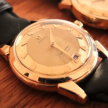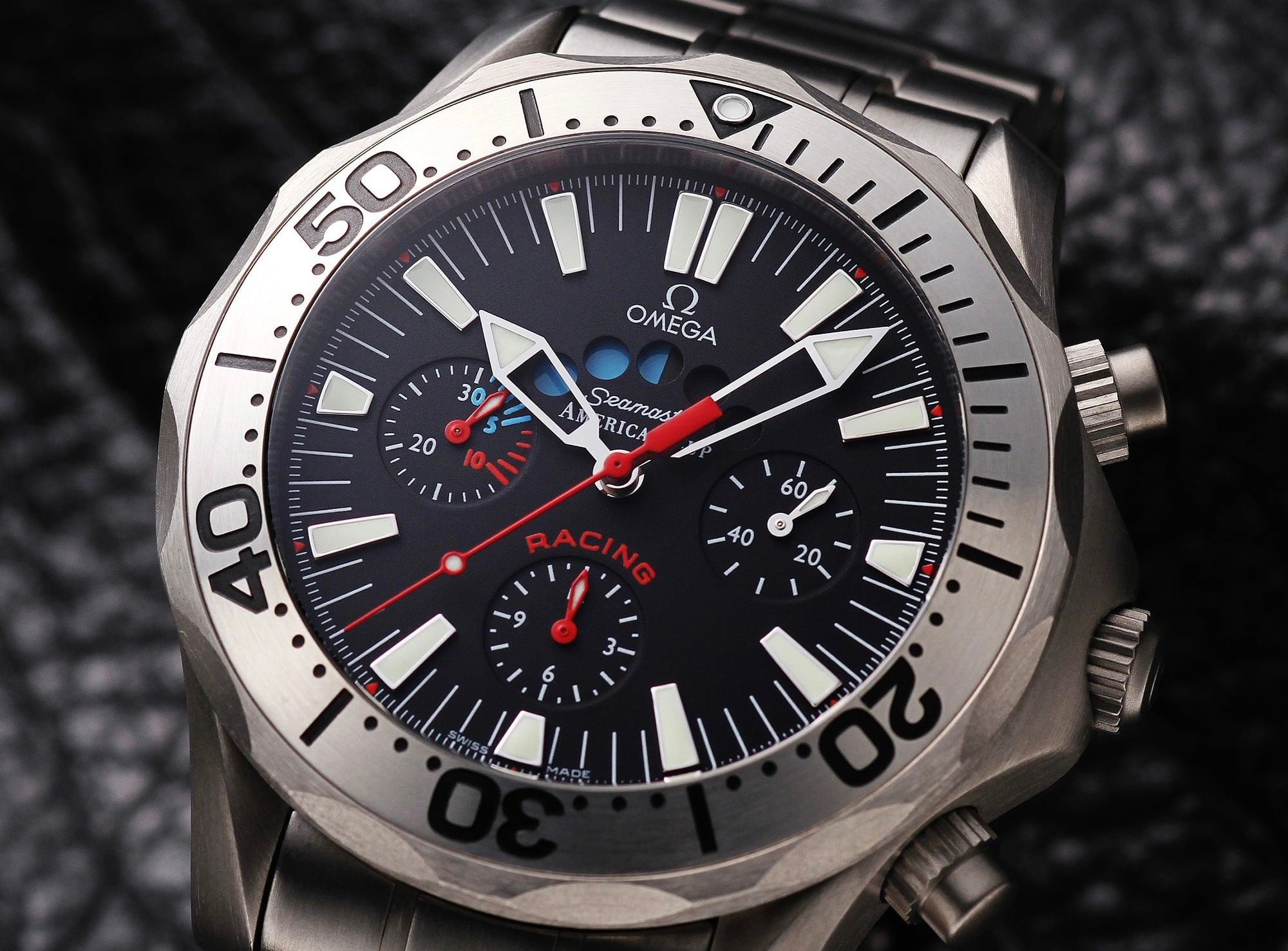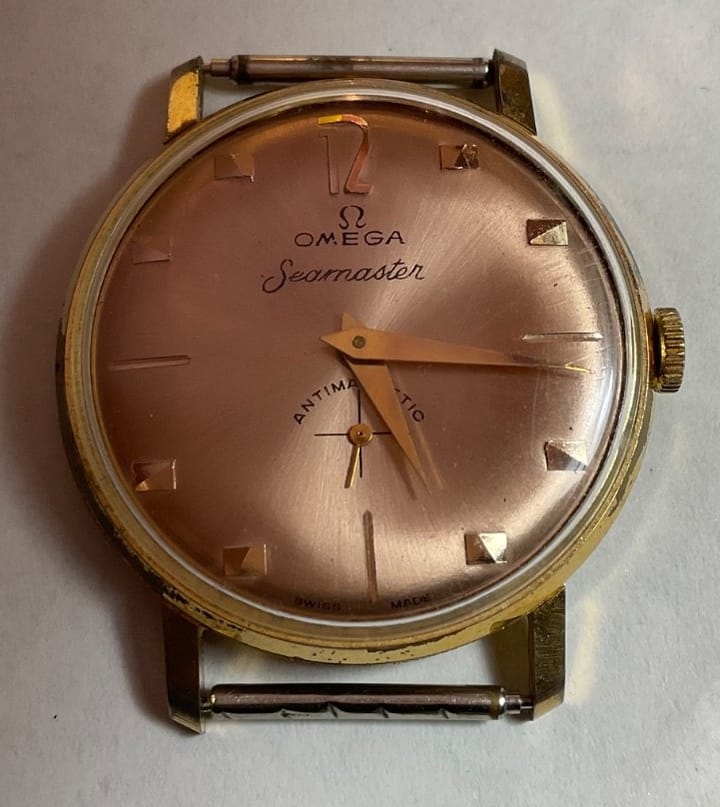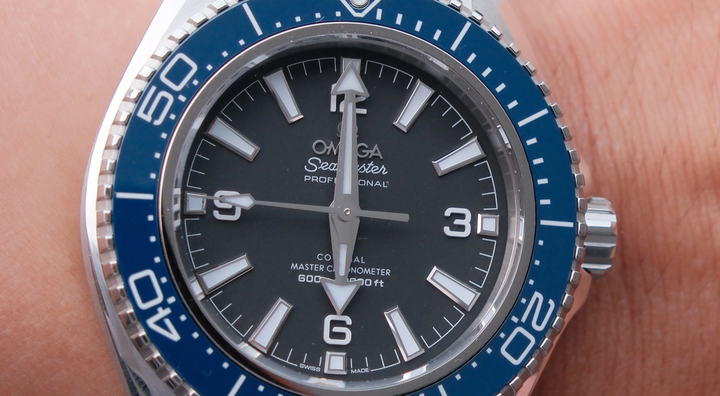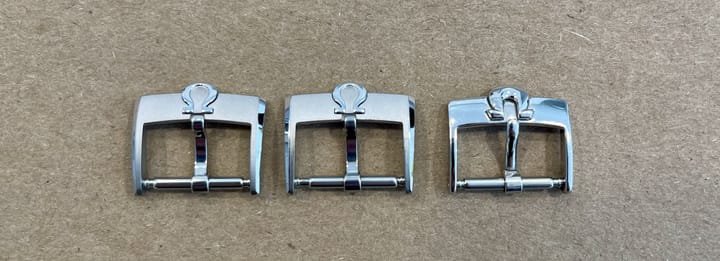Regatta timers are a feature that Omega has repeatedly worked at over the years. While electronic watches tend to dominate the water with their simplicity and loud alarms, the Seamaster Pro 300M Diver Racing 44 mm is possibly the best mechanical regatta timer they’ve produced to date.
Complicated, With Three Ways To Time Events
Previously we looked at a closely related Aqua Terra based version of the Seamaster Pro 300M Racing Chronograph, the NZL-32.
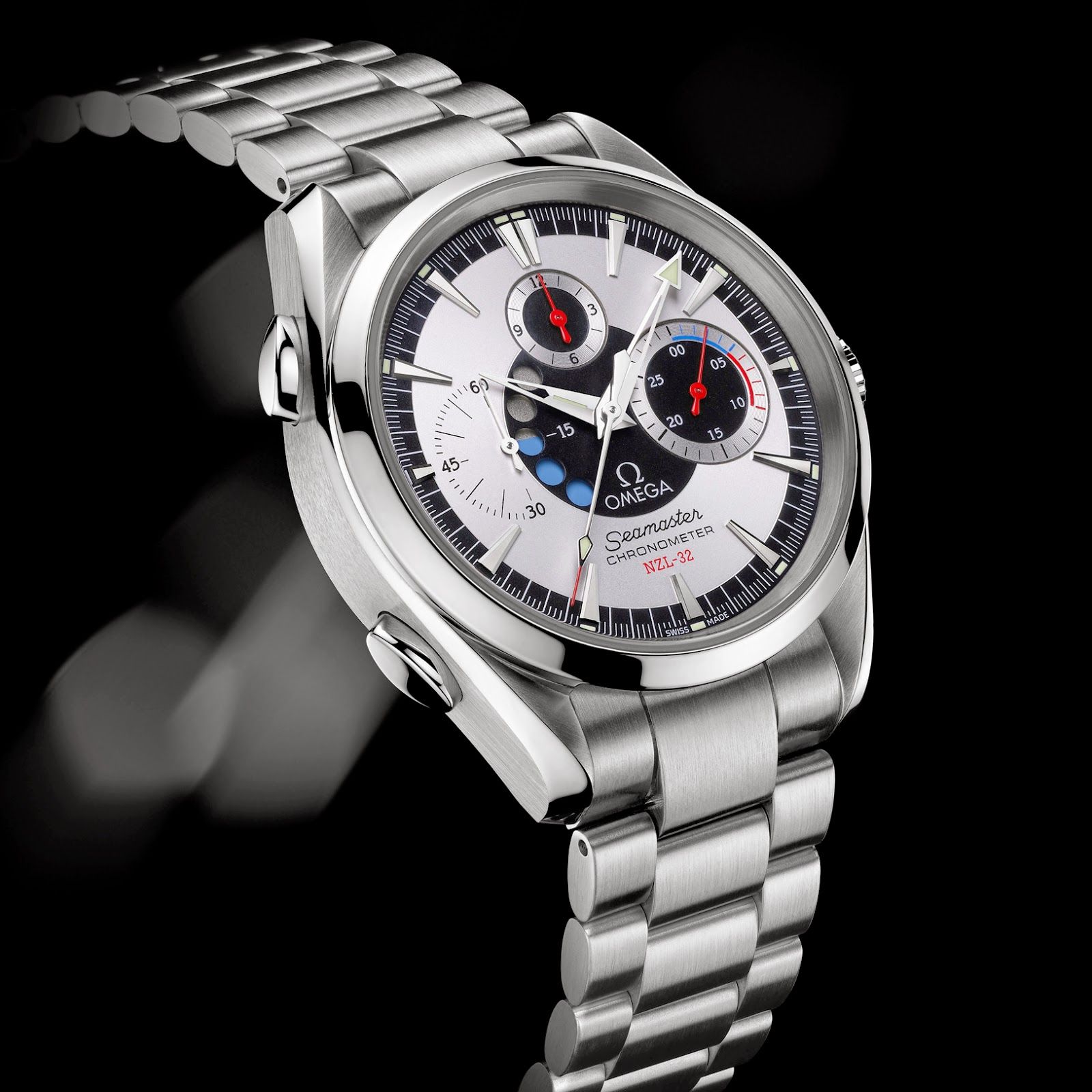
The NZL-32 shares the Calibre 3602 movement in a weird way we'll discuss later but seeks to simplify it to some extent. The Seamaster version does the exact opposite, providing no less than three timing methods, a diving bezel, a traditional chronograph, and colored circles to countdown to race start. That is both a lot of options, and a lot of complexity to cram into a single watch dial. Despite this, these Seamasters do a relatively good job of achieving their goals as a sailing watch compared to many of the others made over the years.
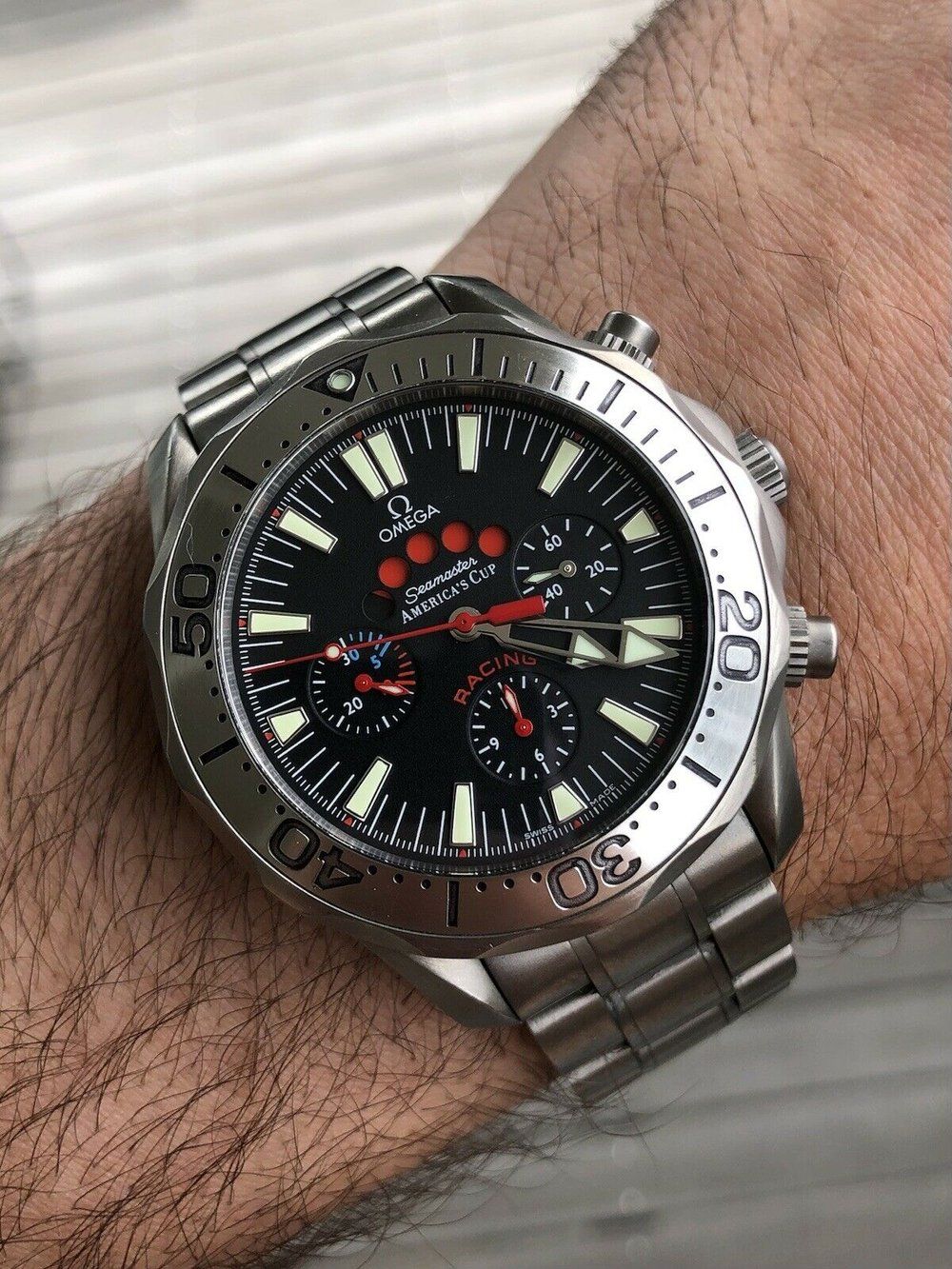
Legibility is really the key to any sailing watch, and it's the reason most mechanical chronographs are simply not up to the job. The large colored discs changing color on the dial of the Seamaster Pro 300M Racing are an excellent approach, bright and vibrant against the black dial and easy to read at the top.
Omega has a long history of making watches with this system of visualising a race start dating all the way back to the Lemania powered Calibre 1345 Omega Regatta. Its an extremely effective system, arguably the best for a mechanical watch and Omega / Lemania have a history of executing it exceptionally well.
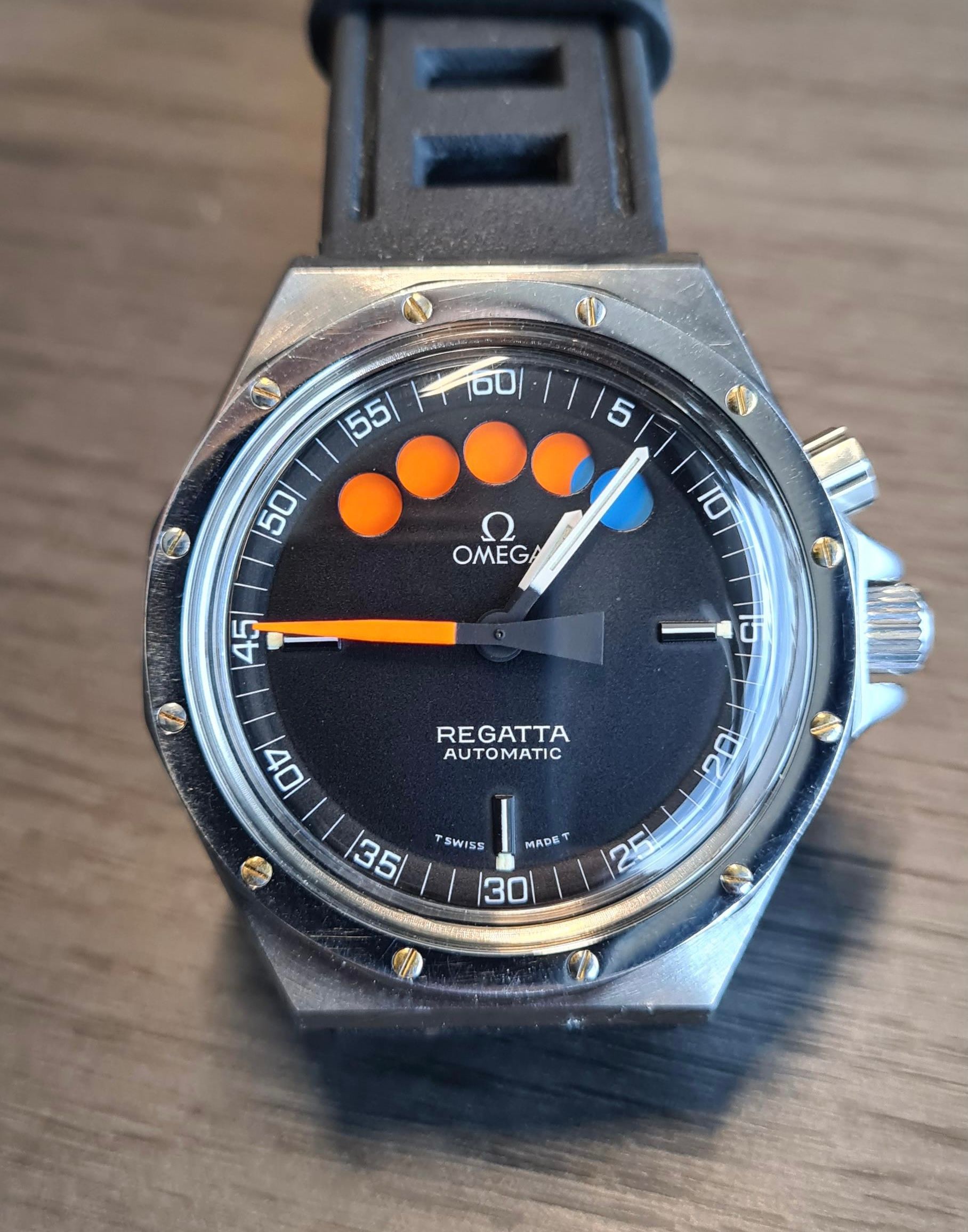
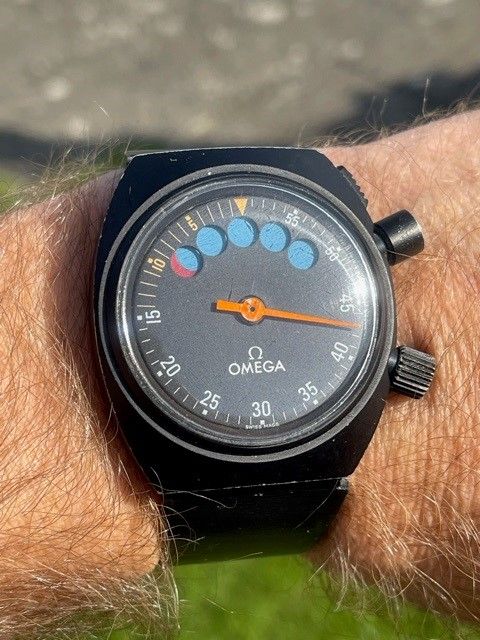
Omega took further steps to enhance the Seamaster Racing's practicality by shrinking the sub-dials down to a much smaller size, and employing special hands which are very thin over the section that would cover the indicator circles. While the bezel doesn't add much over the NZL-32, it does no harm either and could even be useful for tracking secondary information such as the hour of high or low tide.
There was not much thought given to style in these watches, you only get one choice of dial, black, a choice of rubber strap or bracelet, and a choice of steel or titanium, with all options being monochrome. In stark contrast to the regular Seamaster Pro Chronograph range with all the varieties and models on offer, this was a watch really built for a specific purpose and not for fashion.
Case & Bracelet
The Seamaster Pro 300M Diver Racing 44mm shares the overall case design from the 2nd generation Seamaster Pro Diving Chronograph. Size did increase though from 42 mm to 44 mm and thickness is slightly greater due to the piggy-back movement.
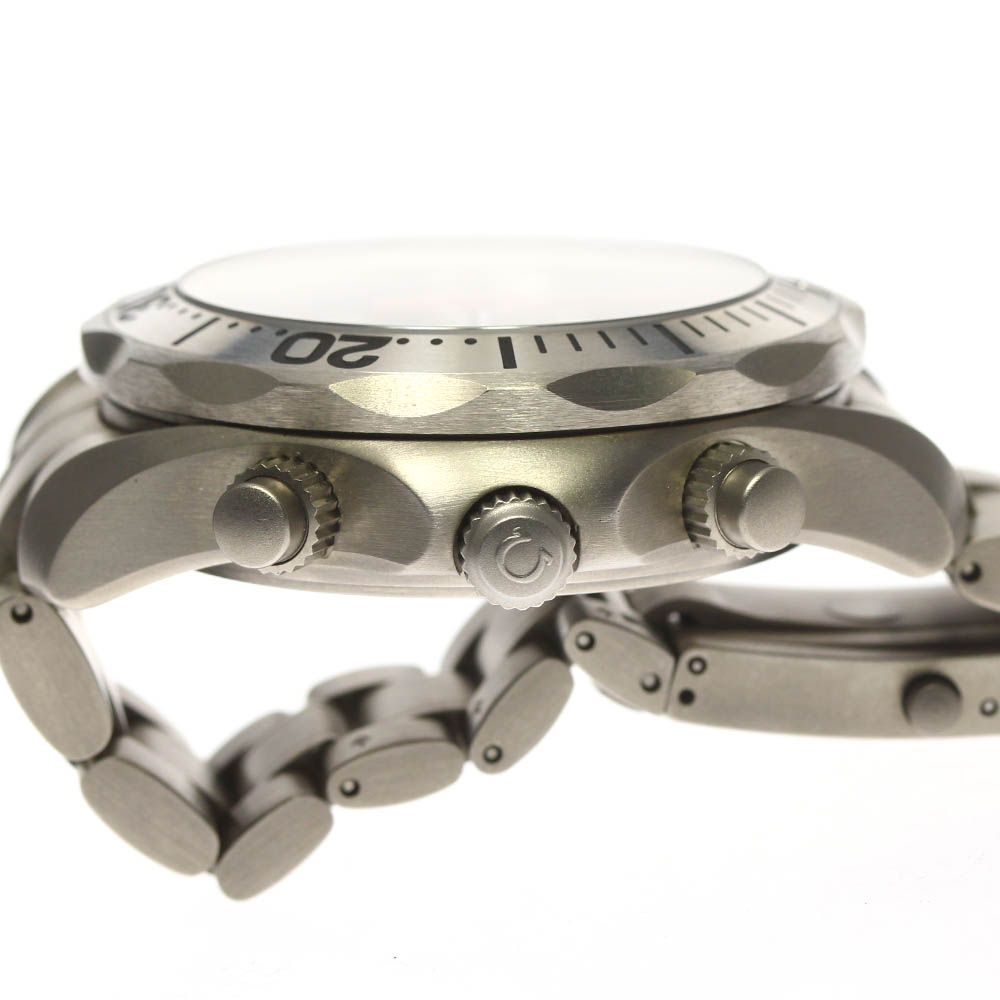
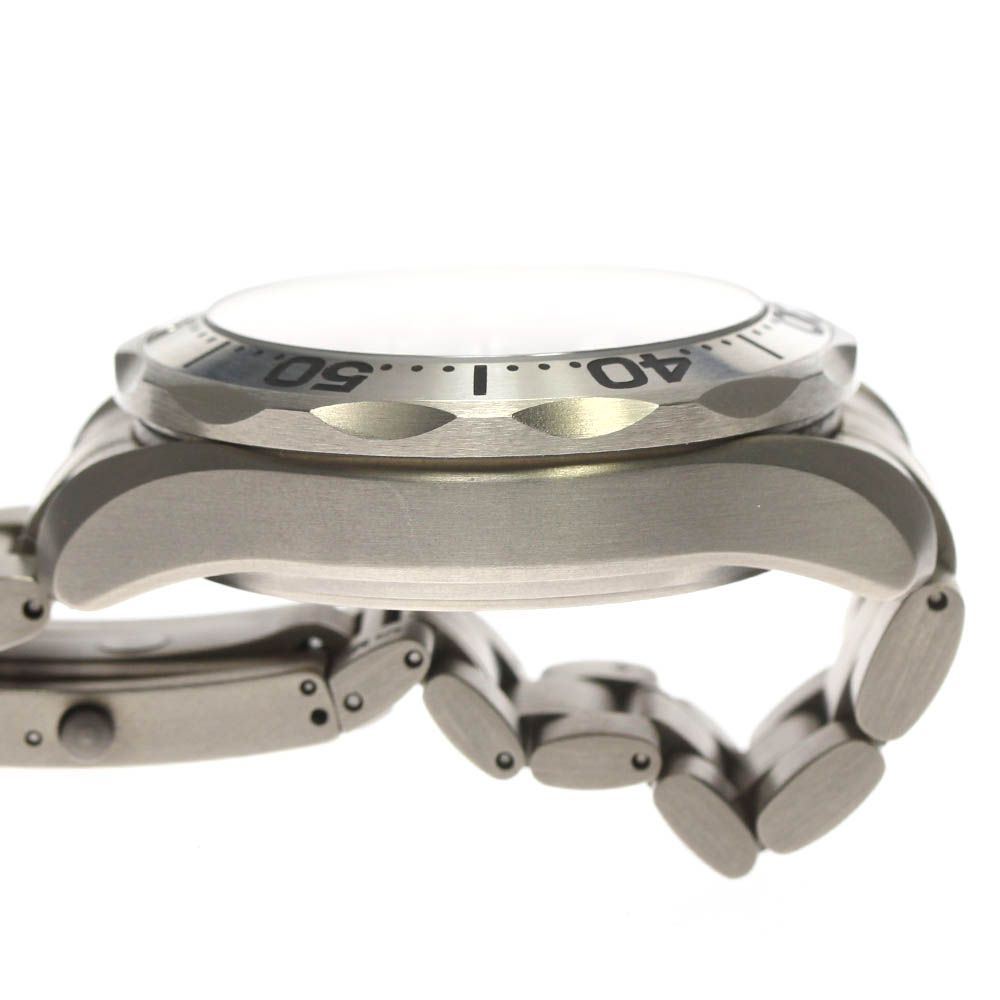
Like other Seamaster Pro Chrono Divers, the highly water-resistant pushers are rated to be used to the full 300-meter depth rating, highly desirable in a watch meant for use on the water. Due to the piggy-back movement, there is an offset between the pushers and the crown, with the crown being further towards the case-back and the pushers being closer to the dial.
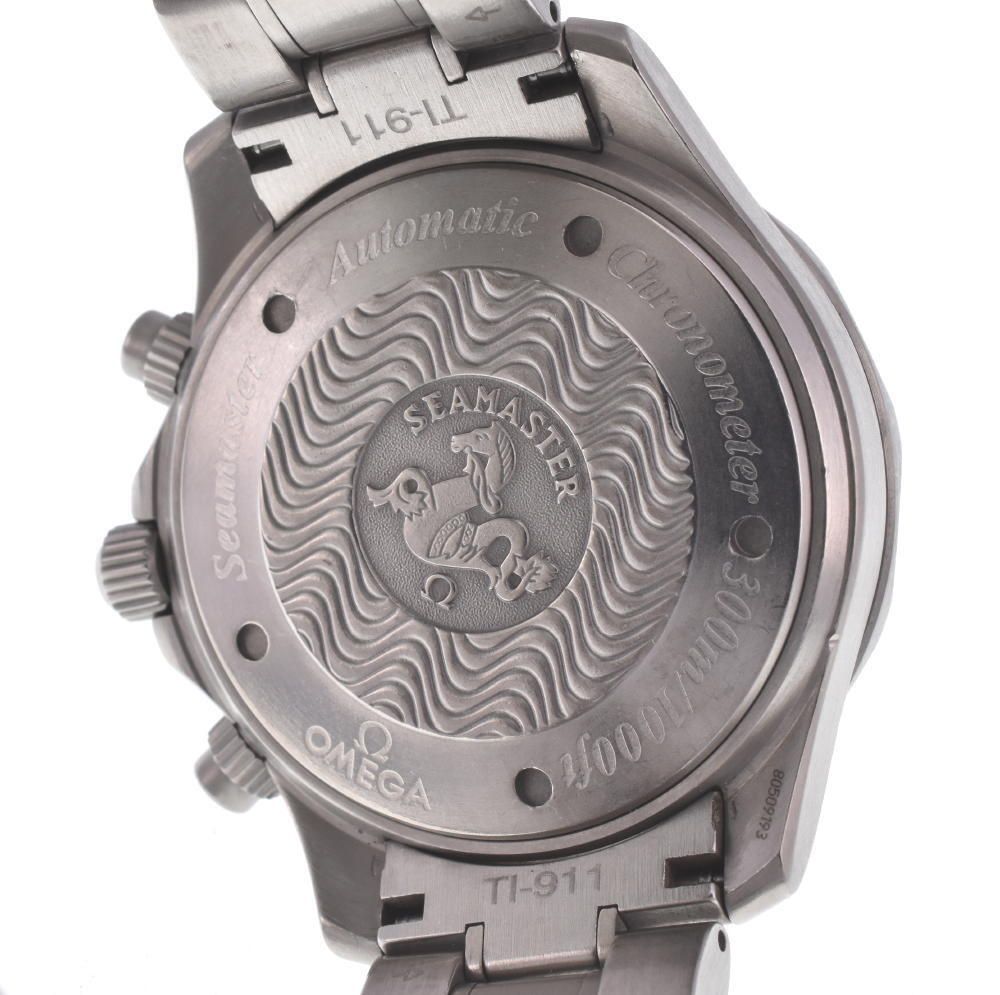
The case design follows the Seamaster Pro pattern with a knurled crown protected by thick crown-guards and fairly unobtrusive pushers. The solid case-back features the iconic Seamaster wave pattern and hippocampus, with Seamaster Automatic Chronometer 300M engraved around the outer edge.
The two bezel options are either simple black on the steel version, or brushed titanium with black inlay on the titanium version. Both of these will serve well on the water thanks to their low glare.
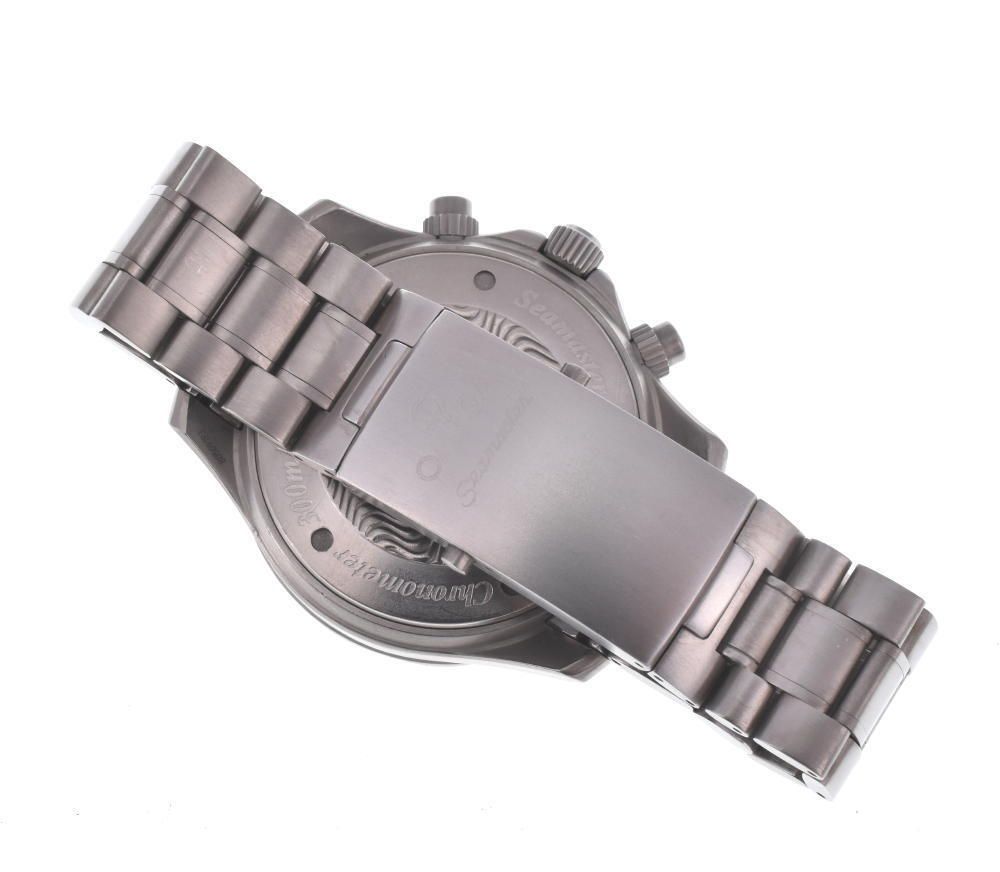
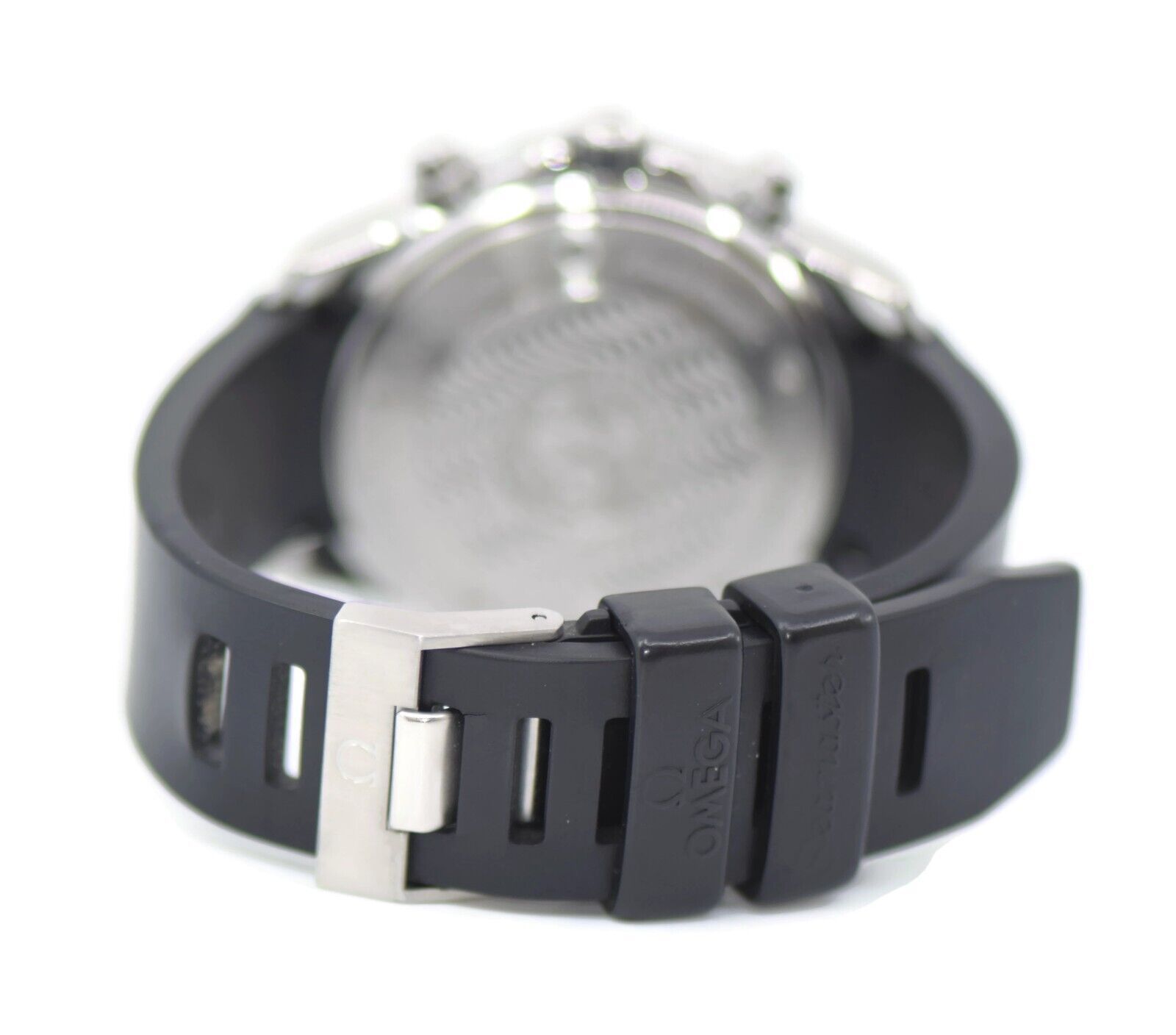
Both steel and titanium versions are available either with a full bracelet in the Speedmaster style with all satin finished links, or on a black Omega rubber strap with tang buckle.
Movement
The movement powering the Seamaster Pro 300M Diver Racing 44mm is the Omega Calibre 3602. This Seamaster is not the only watch to carry this movement, the Seamaster NZL-32 America's Cup Edition models also used it, but with the piggy-back module rotated 180 degrees and with different dial cut-outs.
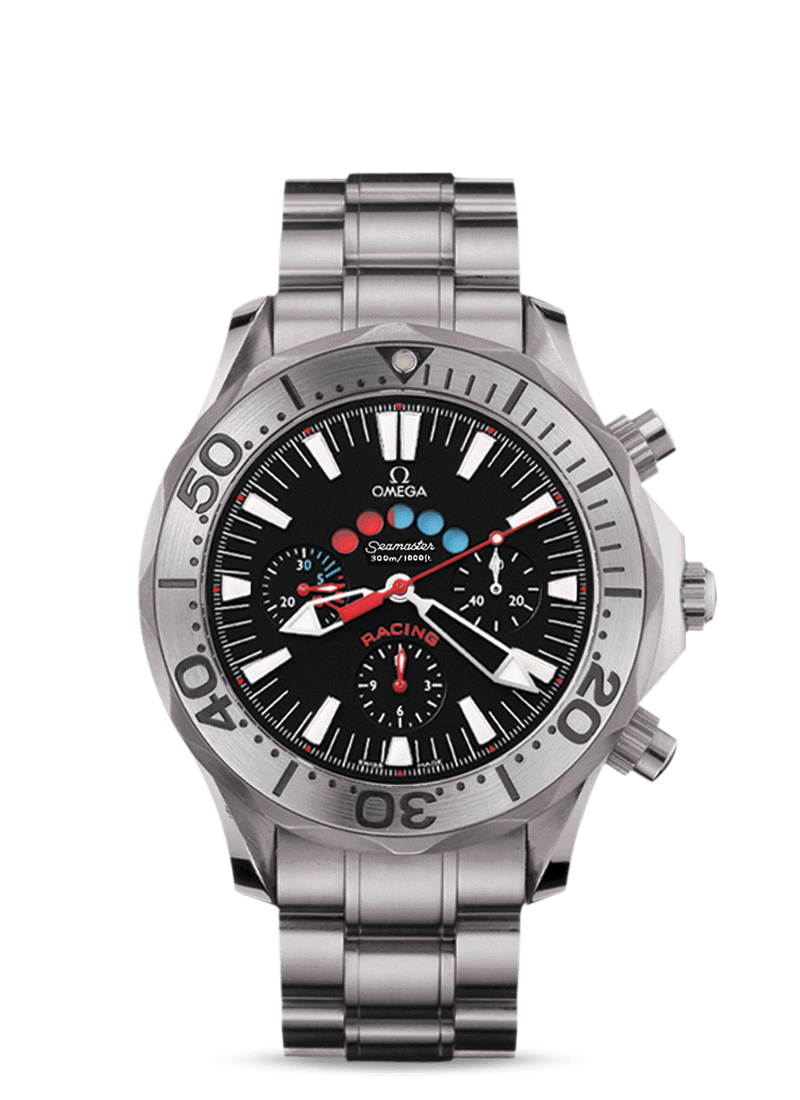
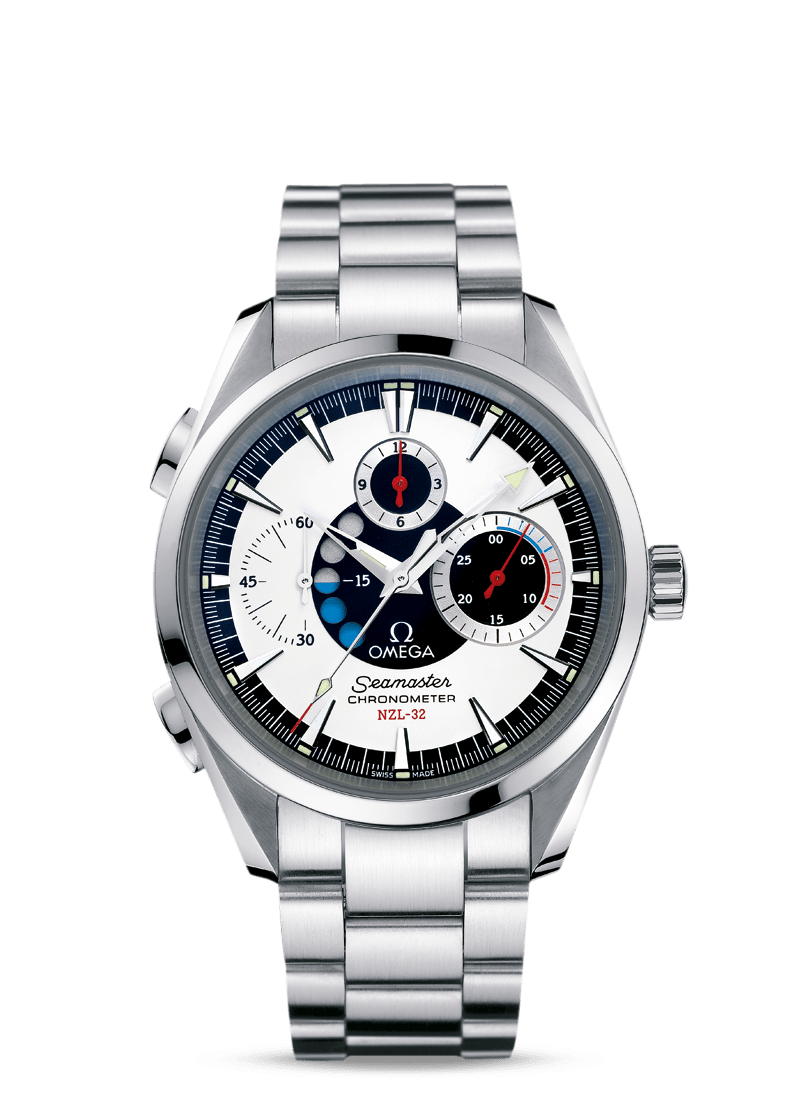
The heart of the Calibre 3602 is the combination of an ETA 2892-A2 movement, and a Dubois-Dépraz 2077 chronograph module, which is placed atop the ETA movement and driven by the seconds hand. The resulting combination beats at the same 28,800 vph of the ETA movement and has a 44-hour power reserve.
The regatta timer function adds an additional disc which makes a full rotation every 15 minutes and is stopped and reset by the same pushers as the chronograph mechanism.
Movements using a Dubois-Dépraz module have been used in everything from the Speedmaster Reduced to the Audemars Piguet Royal Oak Offshore and are proven to be reliable and accurate, even chronometer rated as in the case of the Seamaster Racing. One draw-back of these movements is that most independent watchmakers, even those with access to Omega parts cannot service them any more cheaply than Omega. This is because the modular movement is handled on a core exchange basis rather than by providing individual parts.
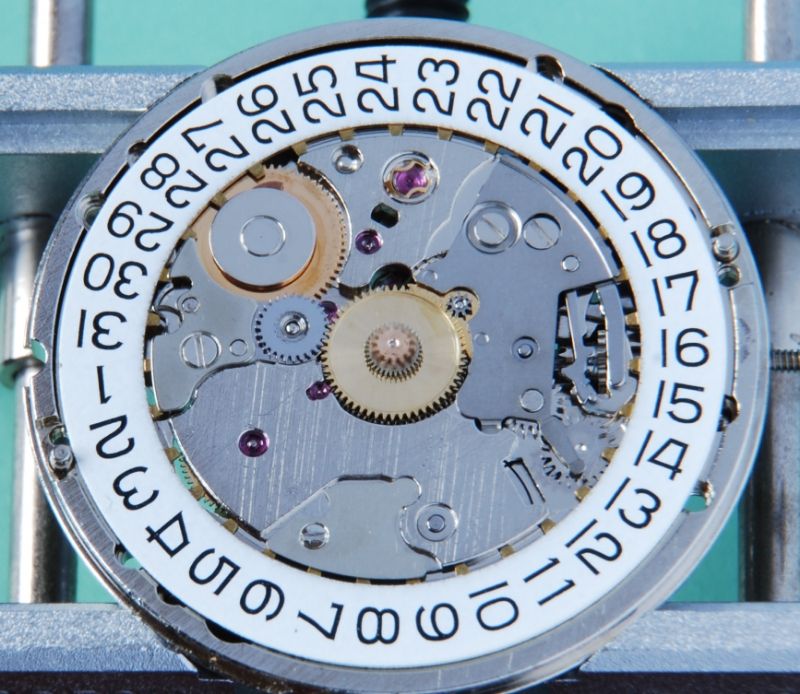
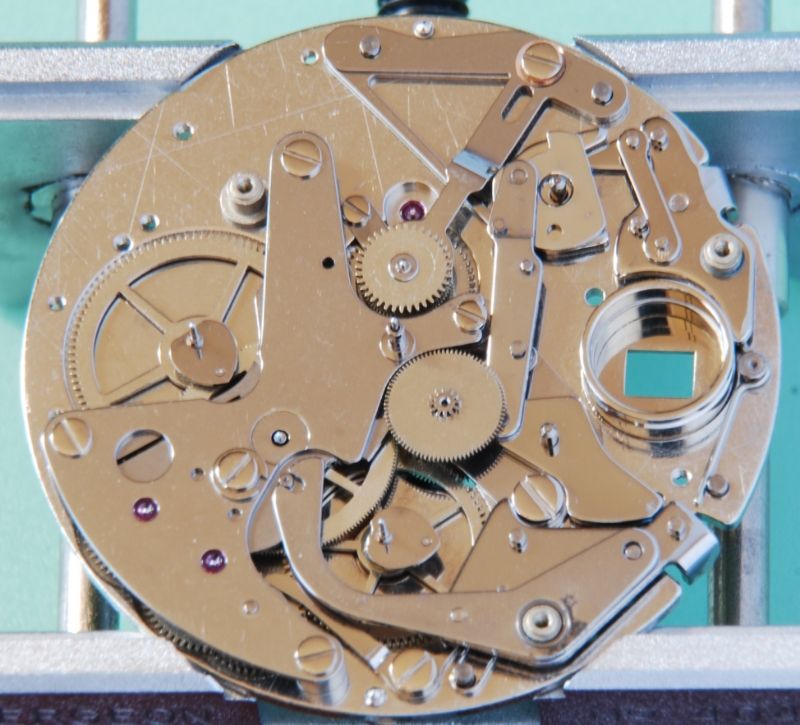
As a result of this, it typically is best to simply take your Seamaster Racing for an Omega factory service through a boutique or authorized dealer and enjoy the watch with the warranty it comes back with. Due to the age of these watches almost all will now be due for service so factor that Omega factory service into your purchase price.
Regatta Timer Usage
The regatta timer mechanism consists of five holes on the top of the dial which act as windows to the painted disc below. That disc below the dial rotates every 15 minutes in time with the chronograph mechanism and is painted black, blue, and red in equal portions with each covering 120 degrees of the disc's rotation. As a result, at 0:00, the 5 windows show all black, at 5:00, they show all blue, and at 10:00 they show all red. If the chronograph is not stopped, the disc will continue rotating and at 15:00 it will show all silver again, repeating the cycle again.
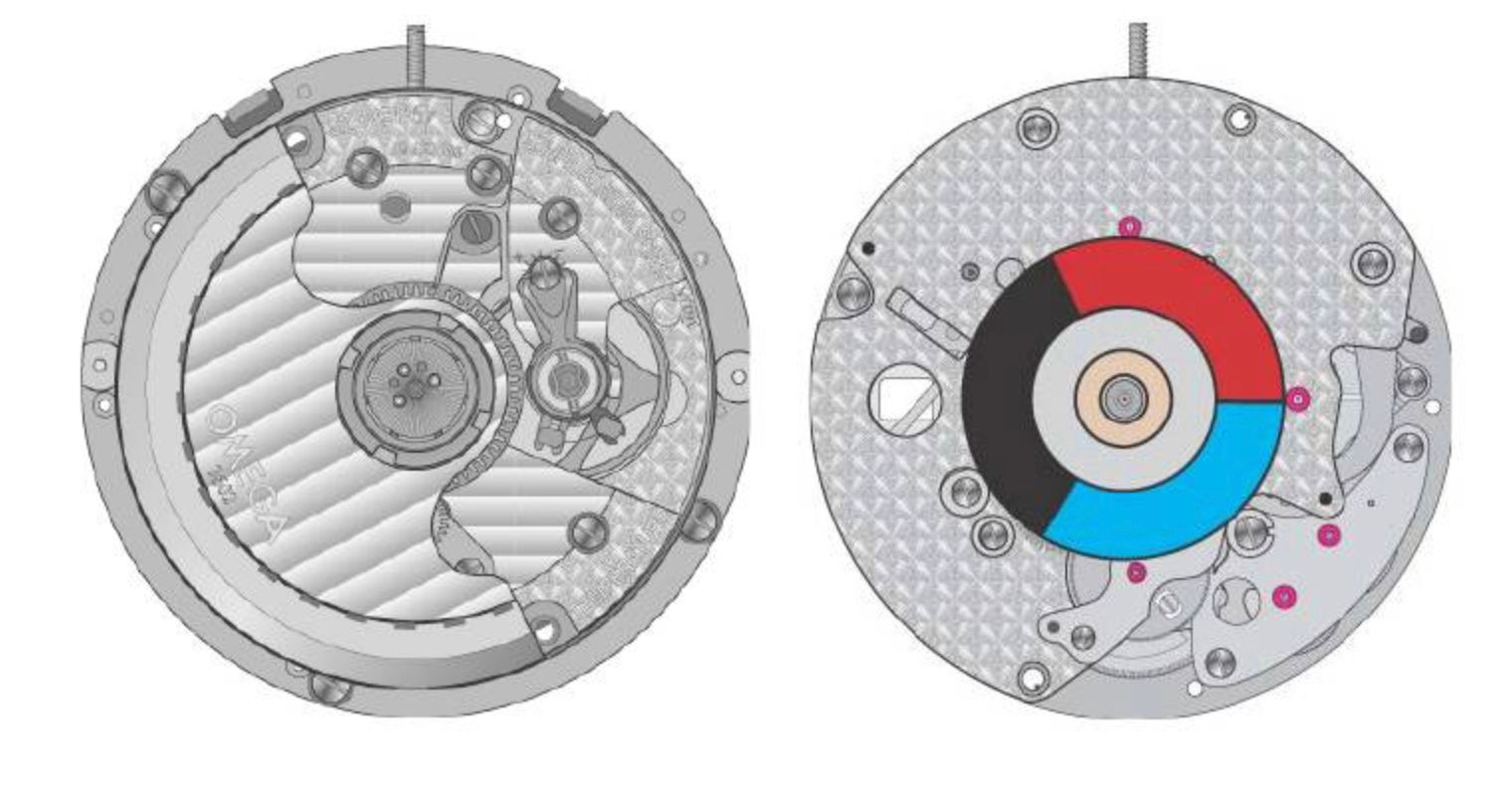
In the image above you can see the disc fitted to the Calibre 3602 and how it fits as snugly as it can within the constraints of the three shafts driving the sub-dial hands. This constraint is the reason the circles could not be further up the dial and larger as is the case in the non-chronograph Seamaster APNEA which uses a much larger disc.
In terms of practicality for sailing, the regatta timer is a bit of a mixed bag. On one hand it definitely has better visibility than the small chronograph sub-dial which is a positive and the red tipped chronograph seconds hand is very visible against the black outer track. Having said that, timing a race start is loud, chaotic, distracting, and filled with yelling. A skipper's eyes need to be on several things at once, and having to check a watch dial periodically isn't going to be as helpful as a digital watch with a loud alarm.
For this reason, if I were to buy an Omega purely for racing it would likely be the X-33 Regatta ETNZ Limited Edition rather than any of the mechanicals.

For daily wear, especially as a lover of sailing, it does make for a very special and unique watch.
Variants
In all, there are 8 unique models of the Seamaster Pro 300M Diver Racing 44mm, but that number overstates how many different options there are.
In reality there are two metals and the option of strap or bracelet. Then each model is duplicated in that there are America's Cup versions and non-America's Cup versions.
While in some watches, like the famous Omega Non-AC Seamaster Pro this makes a very big difference, it is actually remarkably trivial in the 44mm Racing models.
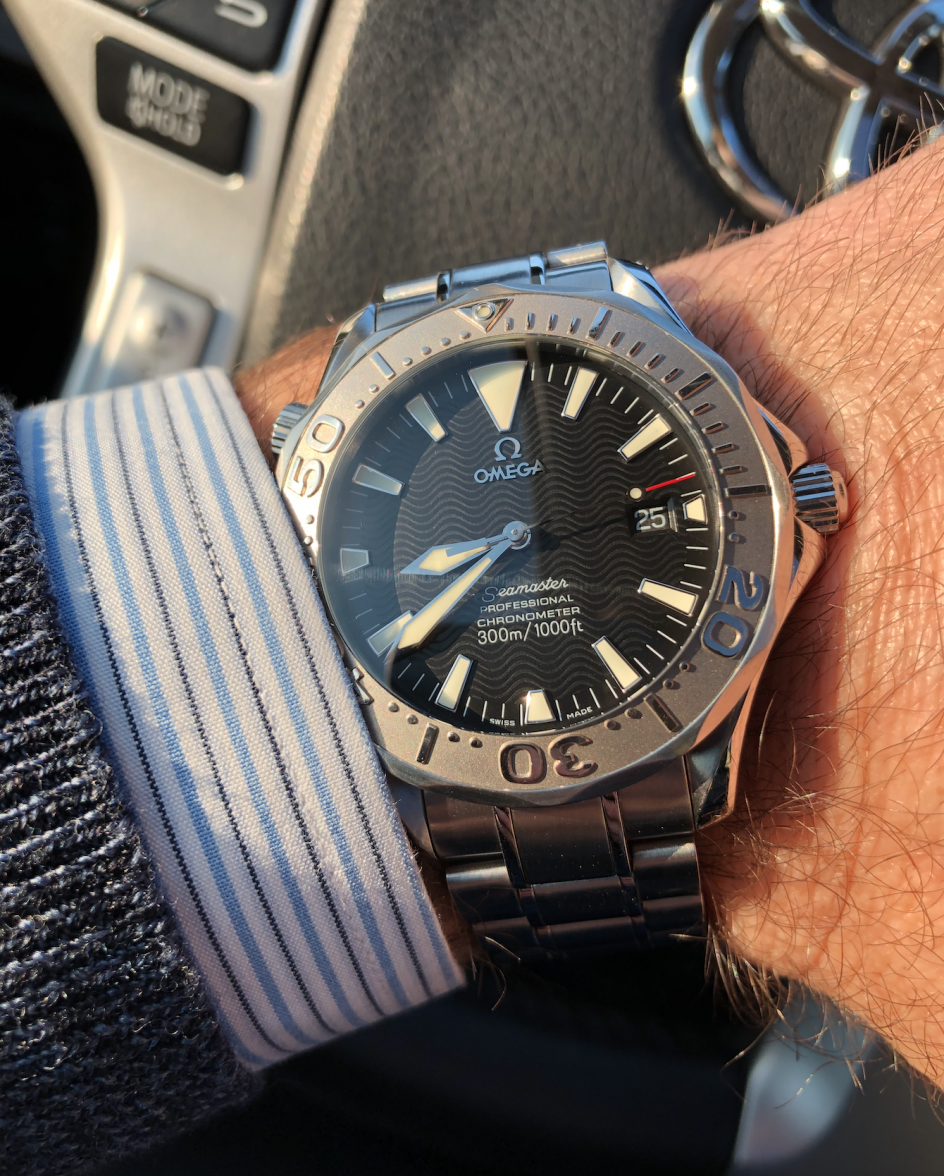
Simply, the America's Cup versions of this watch have the words "America's Cup" written under the word Seamaster in tiny text, while the non-America's Cup versions have 300M / 1000 ft (the depth rating) written there instead. That is the only difference of note, there is no case-back engraving or anything else to denote the America's Cup version aside from that.

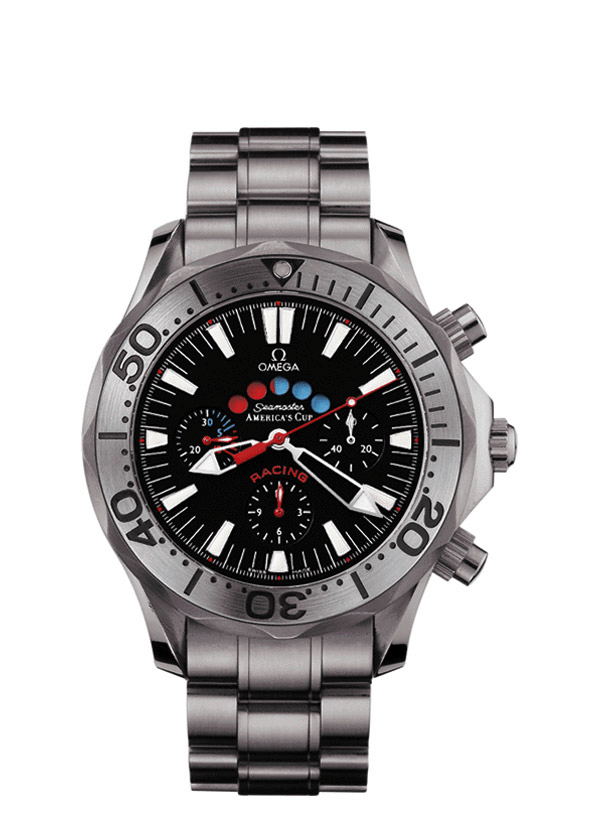
So in the PIC code, any model with "50" for the middle number, such as 2269.50.00 is an America's Cup version, while any model with"52" for the middle number such as 2269.52.00 has the depth rating instead.
That explains half the models in the lineup, of the remaining 4, half are the rubber strap version, which really brings us down to the two metals as the major noteworthy difference.
The steel version is a fairly heavy watch at well over 200 grams and features a painted black aluminium bezel insert, which can be damaged and scratched relatively easily. It is a handsome watch and there is no doubting that, but the weight and greater fragility can become a slight liability in daily use as well as on the water. The non-AC steel version on bracelet is Ref 2569.52.00 & on strap is Ref 2869.52.91. The America's Cup steel version on bracelet is 2569.50.00 & on strap is 2869.50.91.
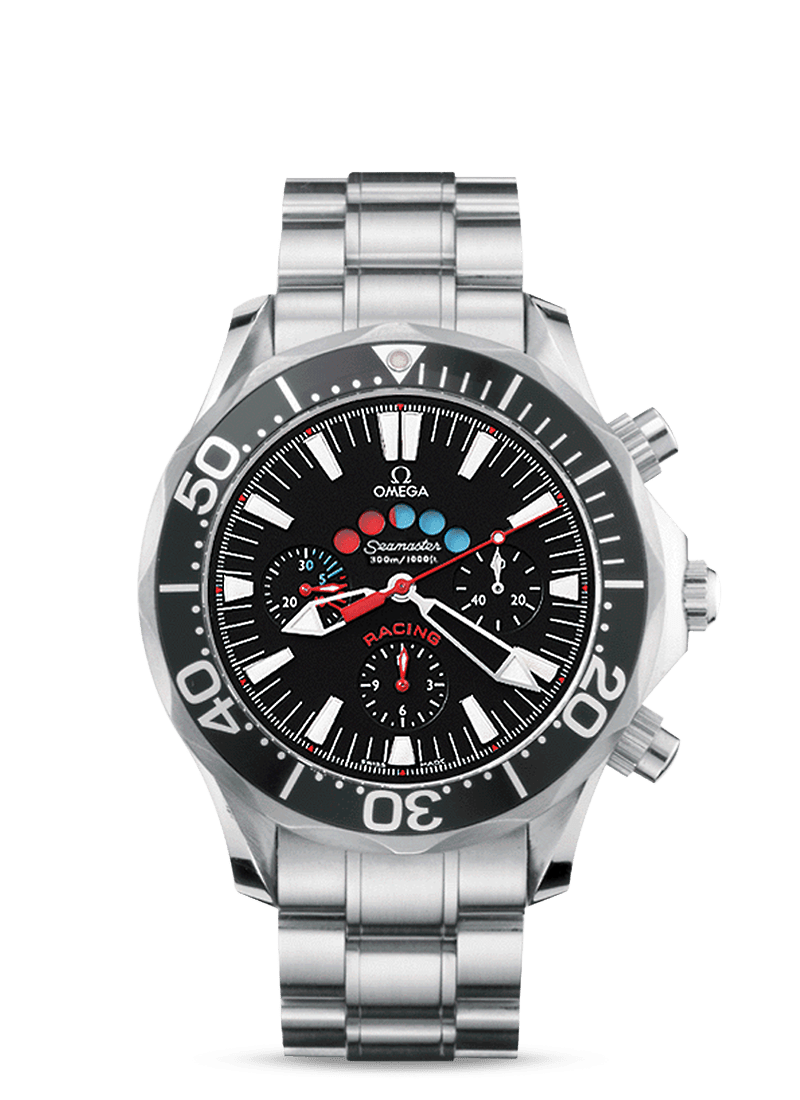
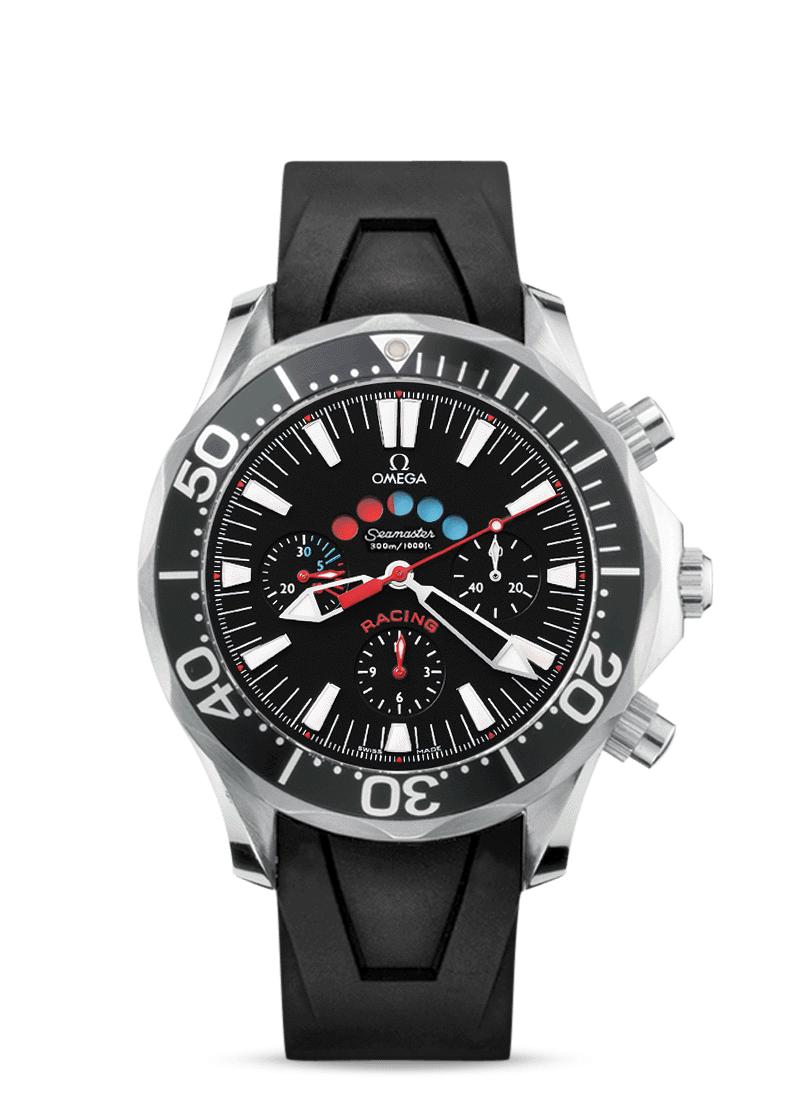
The titanium version is very light at only 137 grams, and the brushed finish titanium bezel looks superb on this watch with this watch case. Omega do a great job in finishing their titanium watches considering how hard a material it is to work with and this watch is no exception. All things considered, the titanium versions are the most desirable and worth waiting for unless you genuinely don't like the metal. The non-AC titanium version on bracelet is Ref 2269.52.00 & on strap is 2969.52.91. The America's Cup titanium version on bracelet is 2269.50.00 & on strap is 2969.50.91.
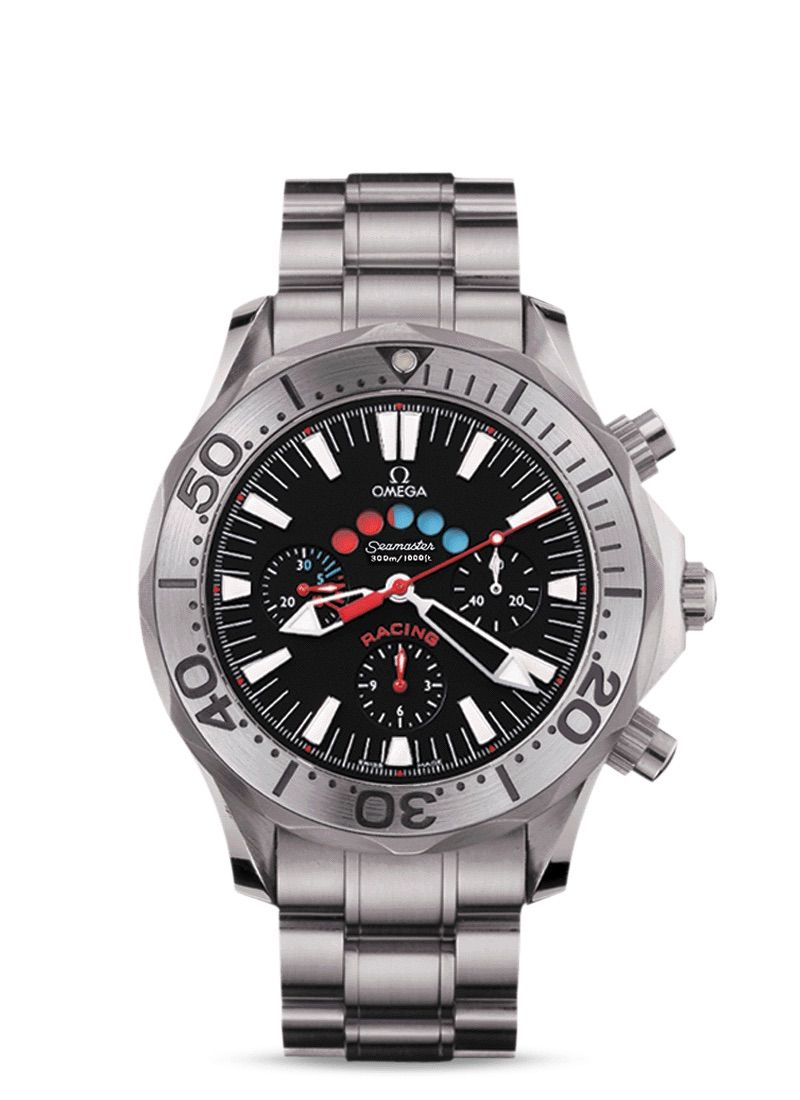
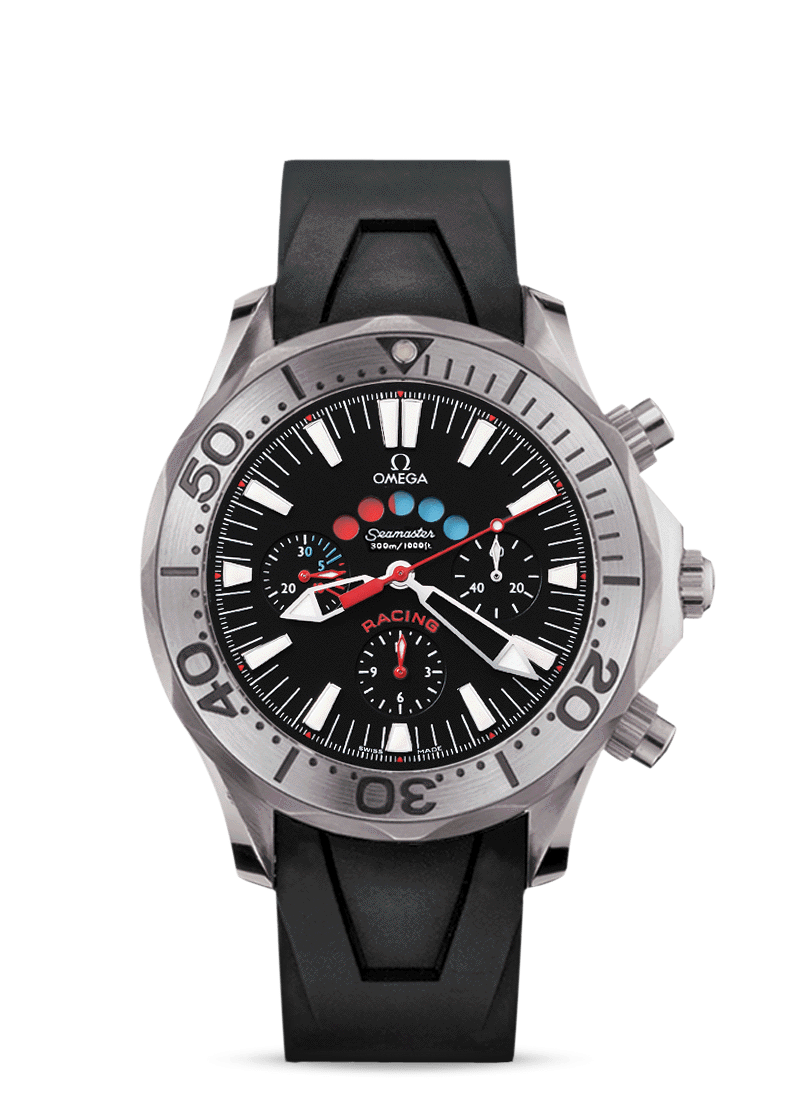
All variants share the exact same dial aside from the America's Cup or depth rating difference. Being produced in 2003, this dial benefits from applied white gold hour markers with high quality lume inside of them, while the Omega logo is painted due to the small size available. the small sub-dials are still quite legible, with running seconds at 3 o'clock, hours at 6 o'clock and chronograph minutes at 9 o'clock. The chronograph minutes sub-dial has a nice touch in that the first 5 minutes are shaded in blue and the second 5 minutes in red as a visual reminder of what the circles in the regatta timer represent. Overall finishing quality is very high, on par with mid to late 2000's Omega's rather than earlier models.
Buying
It doesn't require much effort or money to buy one of these Seamasters, just a decent amount of patience and a preference between steel and titanium. As with most Omega watches it tends to be better both for resale and as a deal in general to get a model on bracelet rather than strap. The reason for this is that even if you don't want the bracelet, you can sell it for good money to offset your purchase price.
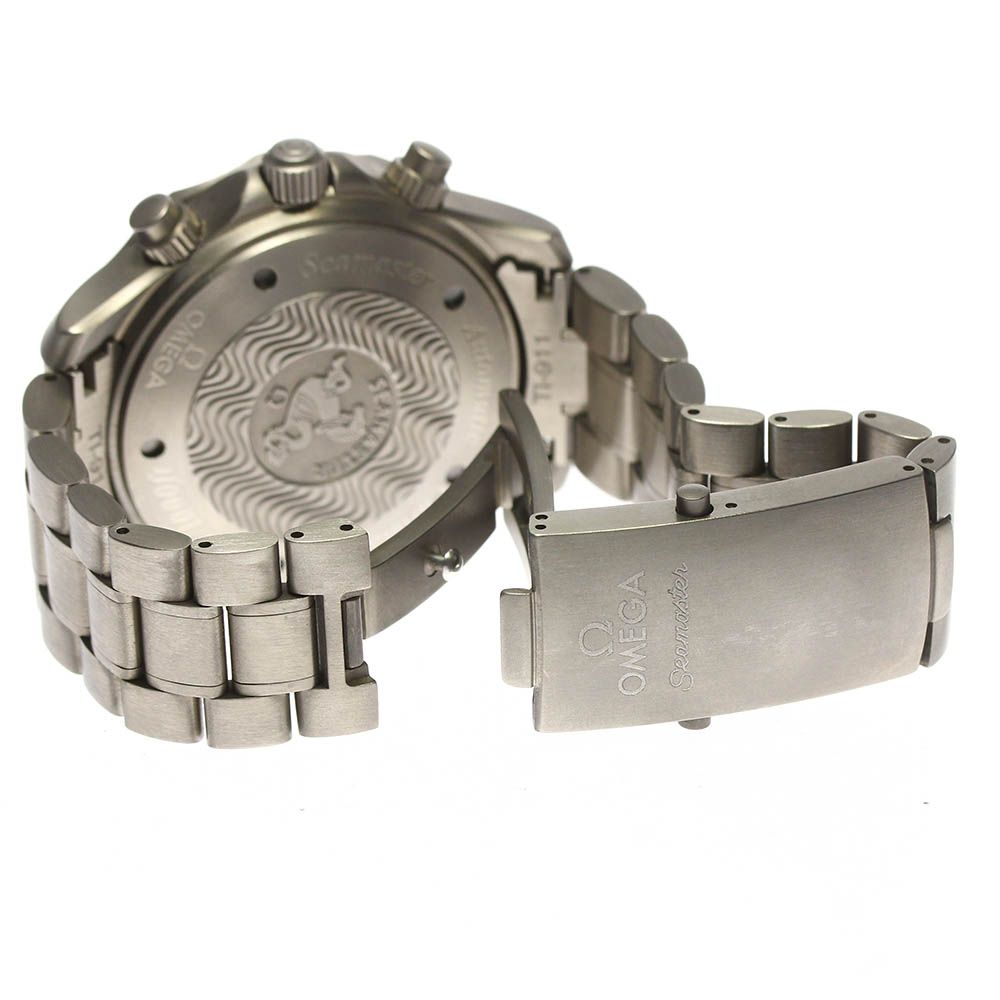
There is no real price difference between the America's Cup and non-America's Cup versions as its such a tiny bit of text that it's largely irrelevant and both are equally good.
The best place to buy these is at auction on eBay or similar platforms when they get listed without reserve. There just isn't much interest in these watches, and this is compounded by the poor labelling many of them have. Some owners call these the "Seamaster Chronograph", some the "Seamaster Regatta", "Seamaster Racing", or even "Omega Sailing Watch". These two factors lead to some very low prices, like this nice titanium example which sold just recently in March 2023 with box, papers, and both bracelet and strap for a very reasonable $2148.00.
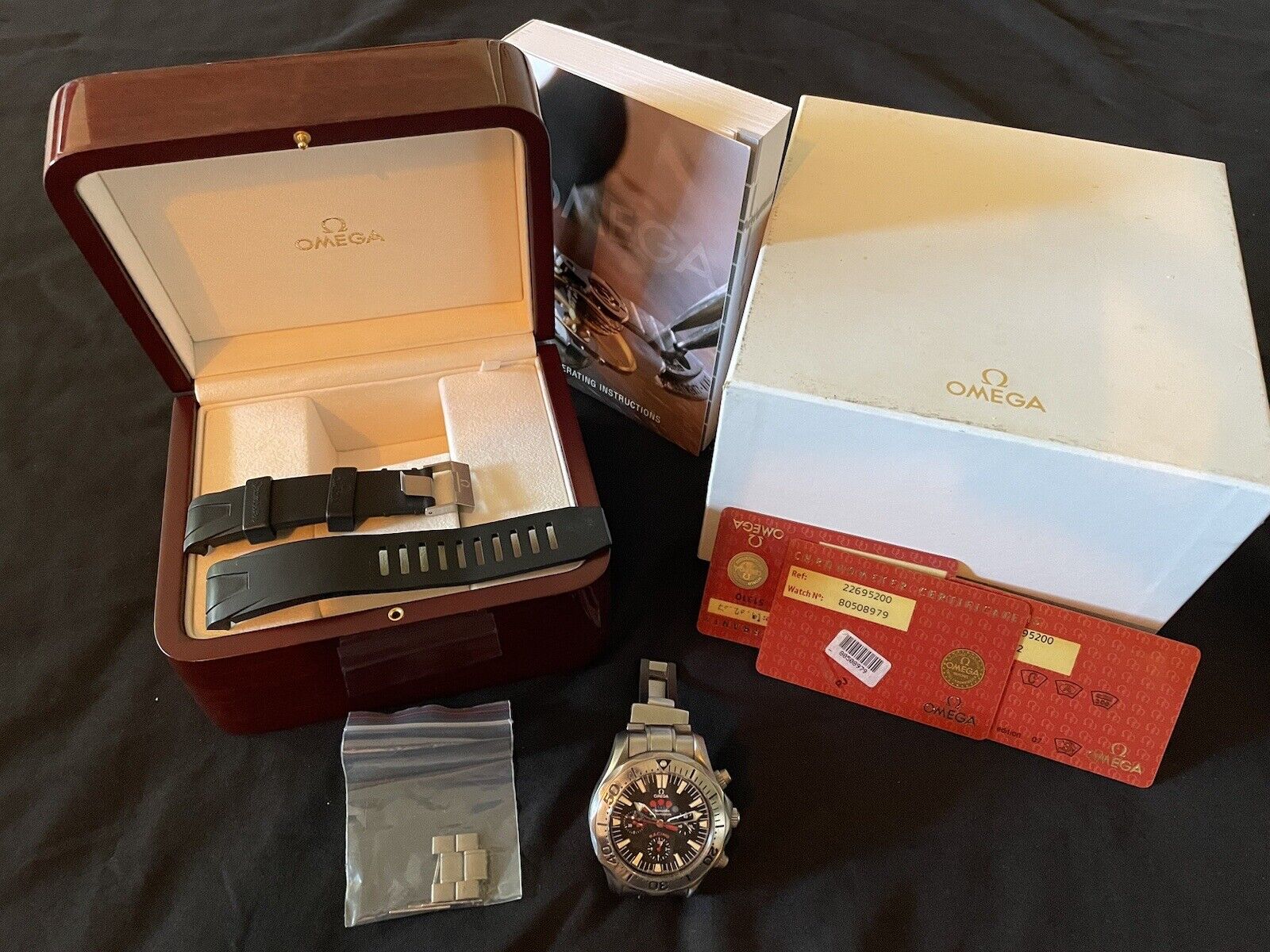

Condition wise, these are highly water-resistant watches and the only signs of wear should be external on the case or bracelet. Look out for severe dents or dings or signs that heavy-handed polishing has removed edges and lines from the case. Both bezels can be dented or scratched, but the black aluminium version is far more prone to visible damage and looking ratty keep in mind that these bezels are sold as a complete unit with the outer metal ring and cost a few hundred dollars to replace.
The titanium version will attract swirls and minor scratches more readily than steel due to the softness of the surface and this is normal, just make sure it doesn't look too worn out or abused.
Due to the nature of the movements in these, they will need factory servicing which comes at a higher cost than a local independent watchmaker and this must also be factored into your purchasing decision.
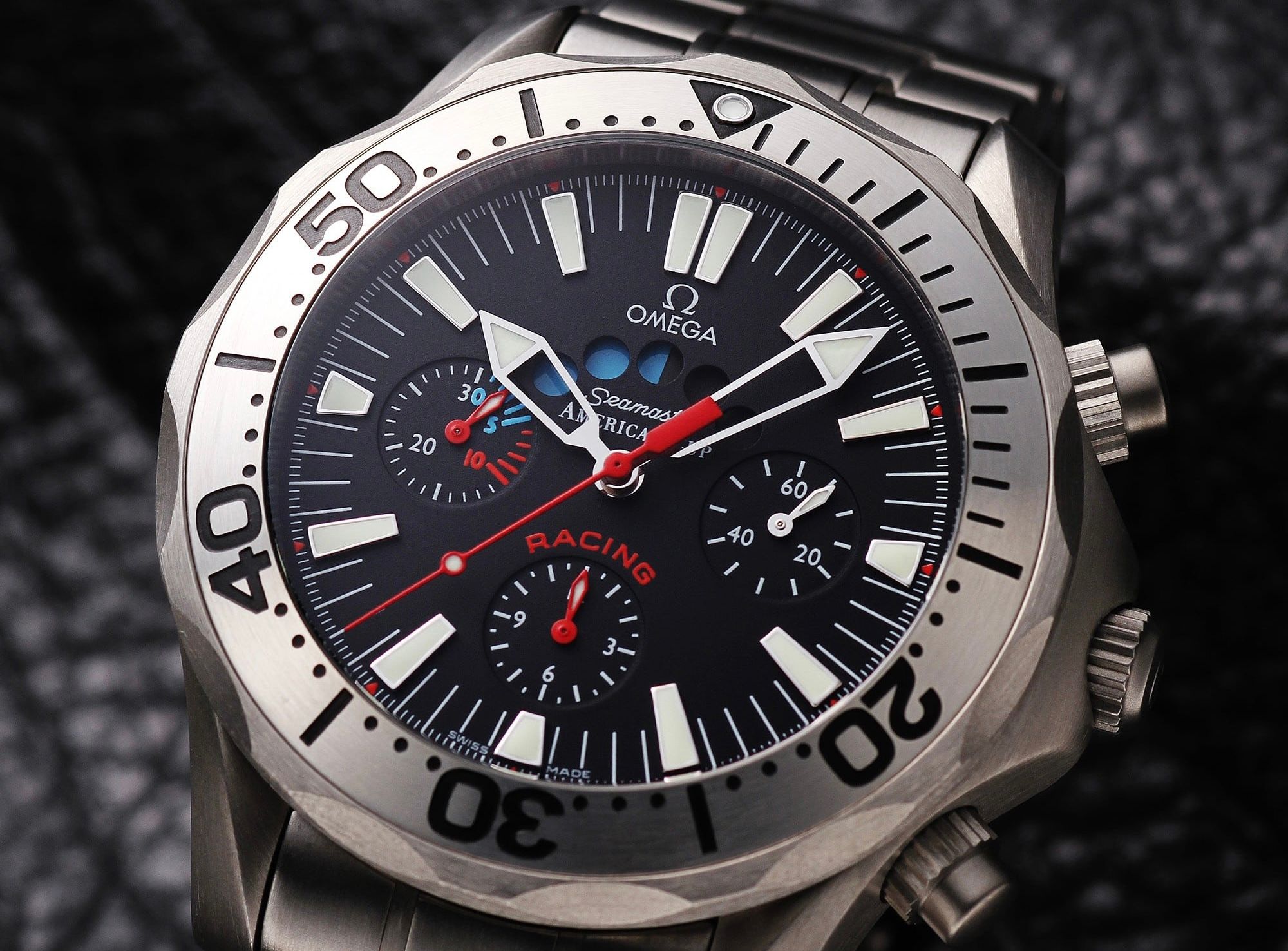
In recent years Omega has moved away from this style of visual regatta countdown timer towards mechanical models that use sub-dials, sometimes equipped with odd-shaped hands to improve legibility. These Seamaster Racing models then represent not only the most practical of mechanical regatta timers made by Omega, but also the last of their breed, for the time at least.
Discussion thread on Omegaforums can be found here:
